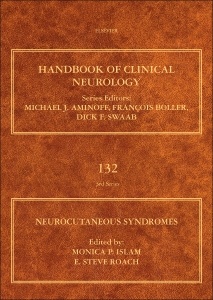Description
Neurocutaneous Syndromes
Handbook of Clinical Neurology Series
Coordinators: Islam Monica P., Roach E. Steve
Language: English
Subject for Neurocutaneous Syndromes:
344 p. · 18.2x26 cm · Hardback
Description
/li>Contents
/li>Readership
/li>Biography
/li>Comment
/li>
Neurocutaneous Syndromes provides the most updated and comprehensive resource on the disorders that lead to the growth of tumors in various parts of the body, those caused by the abnormal development of cells in an embryo and characterized by the presence of tumors in various parts of the body and eyes, including the nervous system, and by certain differences in the skin.
The most common neurocutaneous syndromes include, neurofibromatosis, Sturge-Weber syndrome, tuberous sclerosis, ataxia-telangiectasia, and von Hippel-Lindau disease. Symptoms vary widely and while present early may not express until later in life.
As molecular medicine and genetic science is continuing to impact our understanding of neurocutaneous syndromes, this book also includes the latest molecular and genetic science.
Section 1 Introductory chapters 1. Genetics of neurocutaneous disorders: basic principles of inheritance as they apply to neurocutaneous syndromes - Mustafa Sahin 2. Phenotype/genotype correlations in epidermal nevus syndrome as a neurocristopathy - Laura Flores-Sarnat and Harvey B. Sarnat
Section 2 Neurocutaneous syndromes 3. Acquired neurocutaneous disorders - José Biller and Amre Nouh 4. Neurofibromatosis Type 1 - David H. H. Gutmann and Jacqueline L. Anderson 5. Neurofibromatosis Type 2 - Gareth R. Evans 6. Tuberous sclerosis complex - E. Steve Roach and Monica P. Islam 7. Neurocutaneous melanosis - Monica P. Islam 8. Basal cell nevus syndrome or Gorlin syndrome - Thomas J. Geller and Srikanth Thalakoti 9. PTEN Hamartoma tumor syndrome - Charis Eng 10. von Hippel-Lindau disease - Russell R. Lonser and Prashant Chittiboina 11. Sturge-Weber syndrome - Anne Comi 12. PHACE(s) syndrome - Geoffrey Heyer 13. Hereditary Hemorrhagic Telangiectasia - Melissa G. Chung 14. Ataxia telangiectasia - Andreea Nissenkorn 15. Pseudoxanthoma Elasticum - E. Steve Roach 16. Blue Rubber Bleb Nevus syndrome - Laurence M. Boon 17. Fabry disease - Raphael Schiffmann 18. Hutchison-Gilford progeria syndrome - Leslie B. Gordon 19. Encephalocraniocutaneous lipomatosis - Moise L. Levy and Catherine Massey 20. Incontinentia pigmenti (Bloch-Sulzberger syndrome) - M Narayanan, Sampathkumar Rangasamy and Vinodh Narayanan 21. Hypomelanosis of Ito - Margie Ream 22. Epidermal nevus syndrome - Jeffrey Sugarman 23. Lipoid proteinosis - John McGrath
Neuroscience researchers, clinical neurologists, neuroradiologists, pediatric neurology, neurogenetics
E. Steve Roach, MD is Professor of Pediatrics and Neurology and Vice Chair for Clinical Affairs of the Department of Pediatrics at The Ohio State University College of Medicine. He also serves as Chief of the Section of Pediatric Neurology at Nationwide Children’s Hospital. Roach has served as President of the Child Neurology Society, the main professional organization of child neurologists in North America. Roach is the Editor-in-Chief of Pediatric Neurology and a member of five other journal editorial boards. He has written eight books, including the first textbook on stroke in children, now in its third edition. He has published extensively on tuberous sclerosis complex, Sturge-Weber syndrome, and other neurocutaneous syndromes.
- Provides a comprehensive coverage of neurocutaneous syndromes
- Details the latest molecular and genetic science related to neurocutaneous syndromes
- Presents a focused reference for clinical practitioners and the neuroscience, clinical neurology, and neurogenetics research communities
- Includes updated sections on the latest molecular and genetic science
These books may interest you

Neuro-Oncology, Part II 215.20 €



